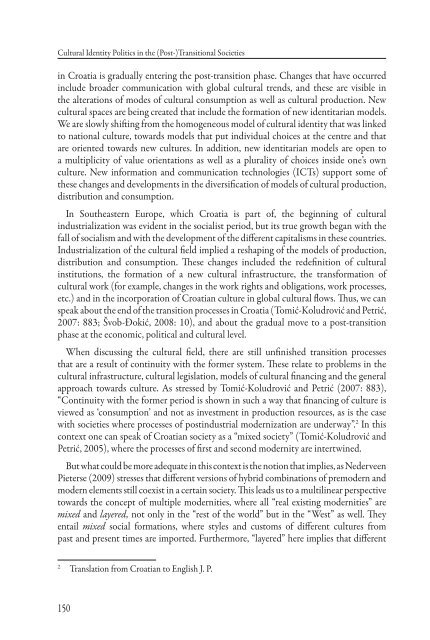Cultural Identity Politics in the (Post-)Transitional Societies
Cultural Identity Politics in the (Post-)Transitional Societies
Cultural Identity Politics in the (Post-)Transitional Societies
Create successful ePaper yourself
Turn your PDF publications into a flip-book with our unique Google optimized e-Paper software.
<strong>Cultural</strong> <strong>Identity</strong> <strong>Politics</strong> <strong>in</strong> <strong>the</strong> (<strong>Post</strong>-)<strong>Transitional</strong> <strong>Societies</strong><br />
<strong>in</strong> Croatia is gradually enter<strong>in</strong>g <strong>the</strong> post-transition phase. Changes that have occurred<br />
<strong>in</strong>clude broader communication with global cultural trends, and <strong>the</strong>se are visible <strong>in</strong><br />
<strong>the</strong> alterations of modes of cultural consumption as well as cultural production. New<br />
cultural spaces are be<strong>in</strong>g created that <strong>in</strong>clude <strong>the</strong> formation of new identitarian models.<br />
We are slowly shift<strong>in</strong>g from <strong>the</strong> homogeneous model of cultural identity that was l<strong>in</strong>ked<br />
to national culture, towards models that put <strong>in</strong>dividual choices at <strong>the</strong> centre and that<br />
are oriented towards new cultures. In addition, new identitarian models are open to<br />
a multiplicity of value orientations as well as a plurality of choices <strong>in</strong>side one’s own<br />
culture. New <strong>in</strong>formation and communication technologies (ICTs) support some of<br />
<strong>the</strong>se changes and developments <strong>in</strong> <strong>the</strong> diversification of models of cultural production,<br />
distribution and consumption.<br />
In Sou<strong>the</strong>astern Europe, which Croatia is part of, <strong>the</strong> beg<strong>in</strong>n<strong>in</strong>g of cultural<br />
<strong>in</strong>dustrialization was evident <strong>in</strong> <strong>the</strong> socialist period, but its true growth began with <strong>the</strong><br />
fall of socialism and with <strong>the</strong> development of <strong>the</strong> different capitalisms <strong>in</strong> <strong>the</strong>se countries.<br />
Industrialization of <strong>the</strong> cultural field implied a reshap<strong>in</strong>g of <strong>the</strong> models of production,<br />
distribution and consumption. These changes <strong>in</strong>cluded <strong>the</strong> redef<strong>in</strong>ition of cultural<br />
<strong>in</strong>stitutions, <strong>the</strong> formation of a new cultural <strong>in</strong>frastructure, <strong>the</strong> transformation of<br />
cultural work (for example, changes <strong>in</strong> <strong>the</strong> work rights and obligations, work processes,<br />
etc.) and <strong>in</strong> <strong>the</strong> <strong>in</strong>corporation of Croatian culture <strong>in</strong> global cultural flows. Thus, we can<br />
speak about <strong>the</strong> end of <strong>the</strong> transition processes <strong>in</strong> Croatia (Tomić-Koludrović and Petrić,<br />
2007: 883; Švob-Đokić, 2008: 10), and about <strong>the</strong> gradual move to a post-transition<br />
phase at <strong>the</strong> economic, political and cultural level.<br />
When discuss<strong>in</strong>g <strong>the</strong> cultural field, <strong>the</strong>re are still unf<strong>in</strong>ished transition processes<br />
that are a result of cont<strong>in</strong>uity with <strong>the</strong> former system. These relate to problems <strong>in</strong> <strong>the</strong><br />
cultural <strong>in</strong>frastructure, cultural legislation, models of cultural f<strong>in</strong>anc<strong>in</strong>g and <strong>the</strong> general<br />
approach towards culture. As stressed by Tomić-Koludrović and Petrić (2007: 883),<br />
“Cont<strong>in</strong>uity with <strong>the</strong> former period is shown <strong>in</strong> such a way that f<strong>in</strong>anc<strong>in</strong>g of culture is<br />
viewed as ‘consumption’ and not as <strong>in</strong>vestment <strong>in</strong> production resources, as is <strong>the</strong> case<br />
with societies where processes of post<strong>in</strong>dustrial modernization are underway”. 2 In this<br />
context one can speak of Croatian society as a “mixed society” (Tomić-Koludrović and<br />
Petrić, 2005), where <strong>the</strong> processes of first and second modernity are <strong>in</strong>tertw<strong>in</strong>ed.<br />
But what could be more adequate <strong>in</strong> this context is <strong>the</strong> notion that implies, as Nederveen<br />
Pieterse (2009) stresses that different versions of hybrid comb<strong>in</strong>ations of premodern and<br />
modern elements still coexist <strong>in</strong> a certa<strong>in</strong> society. This leads us to a multil<strong>in</strong>ear perspective<br />
towards <strong>the</strong> concept of multiple modernities, where all “real exist<strong>in</strong>g modernities” are<br />
mixed and layered, not only <strong>in</strong> <strong>the</strong> “rest of <strong>the</strong> world” but <strong>in</strong> <strong>the</strong> “West” as well. They<br />
entail mixed social formations, where styles and customs of different cultures from<br />
past and present times are imported. Fur<strong>the</strong>rmore, “layered” here implies that different<br />
2<br />
Translation from Croatian to English J. P.<br />
150




